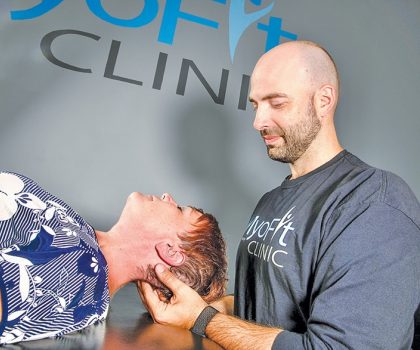Neck pain: Surgery not needed

By Dr. Adam Cramer, PT, DPT; MyoFit Clinic
No matter the source, neck pain can lead to chronic deficits, limiting quality of life and function.
It is important to see a licensed Doctor of Physical Therapy first to assess your range of motion and evaluate how your body is compensating for the neck pain. We see a lot of people get misdiagnosed based on their symptoms and functional limitations, or the findings from an X-ray or MRI, which result in invasive procedures, including surgery and nerve blocks. If you don’t want surgery, don’t consult with a surgeon. And if you want to be treated in an environment where there’s no conflict of interest, see an independent physical therapy practice first vs. a physician-owned practice where surgery is prioritized.
The Causes of Neck Pain
Besides traumatic injury, such as a car accident or getting hit in the head, poor posture is a major problem for many who develop neck pain. If you lean your head and shoulders forward constantly instead of sitting/standing up straight, sooner or later your neck is going to start hurting. When you sit, if your head is slanting far forward of your shoulders, that is an indication you need to adjust your posture. Poor posture places your neck and upper back in a significant mechanical disadvantage, and the surrounding muscles, if not strong enough, will strain, get tighter and create painful muscle spasms that can lead to years of chronic pain.
Poor mechanics with overhead lifting, weightlifting and poor sleeping positions can cause neck pain as well, but with the correct demonstration and training from a Doctor of Physical Therapy, you can learn how to avoid neck pain all together.
Best Treatment for Neck Pain
Regardless of the cause, what happens when you find yourself experiencing severe neck pain? What kinds of treatment should you engage in to help the healing process and not make things even worse?
By seeing a Doctor of Physical Therapy first, they are able to fully evaluate your neck pain, find the root source, identify limitations and work at improving on those limitations by providing fast-acting pain relieving techniques such as hands-on manual therapy, massage, dry needling, trigger point release and moist heat, which will help the surrounding strained muscles let go in order to alleviate the limited movement surrounding nerves and joints to restore full motion. You will be taught exactly how to reduce your pain through simple effective stretching, to mimic the mobility treatment performed by your Doctor of Physical Therapy. That way, you can reduce your own pain right when you need it the most. Once mobility has been restored, strengthening exercises of the upper back and postural neuromuscular reeducation training is performed to stabilize the neck so it is more durable and less vulnerable when it’s placed in challenging postural positions.
Never let any provider adjust or manipulate your neck. The cervical vertebrae and joints are not necessarily the problem. It’s the muscles surrounding the vertebrae that restrict joint movement, causing painful symptoms. If you have a problem with movement, focus on the structures that make you move and you will move better. Receive treatment that promotes movement, and you will move better. This is why we utilize heat, which makes movement easier, along with manual, hands-on treatment to help the muscles move better. In return, the joints will move better and ultimately alleviate all your symptoms for the long term. If a provider adjusts or manipulates your vertebrae/joints without addressing any other surrounding muscle limitations, you will strain the muscles further and damage the structures, ultimately restricting the vertebral movement further and symptoms will be exacerbated.
Controlling Neck Pain
Like anything else, prevention of neck pain is desired even more than finding ways to treat yourself once it has occurred.
With neck pain, you should use heating pads or warm showers directed at your neck in order to promote blood flow to loosen up tight muscles and promote healing of damaged structures. Improving movement and focusing on the movement that is the most limited will be the best way to help return to normal. Lightly stretching the restricted muscle will help your neck move better, alleviating the stress of that area.
If you need to use your phone for long periods of time, try to hold it so that your neck is aligned with your shoulders, not leaning forward from them. Your neck was not designed to be held in such a position, and even if you have been getting away without pain, it will catch up with you.
Be sure that you are not sitting excessively to the left or to the right, this will place excessive stress on the opposite neck muscle group, excessively activating that muscle, which will ultimately fatigue then start straining and causing pain. Be sure to moderate your sitting positions, alternating between leaning to the left and right.
If you or a loved one is suffering from neck pain, please consult with a Doctor of Physical Therapy at MyoFit Clinic immediately.
Adam M. Cramer, PT, DPT, is a licensed Doctor of Physical Therapy, pain specialist and founder of the MyoFit Clinics in Chardon, Ashtabula and Middlefield. Visit MyoFitClinic.com, or call 440-286-1007 for help with your pain.
